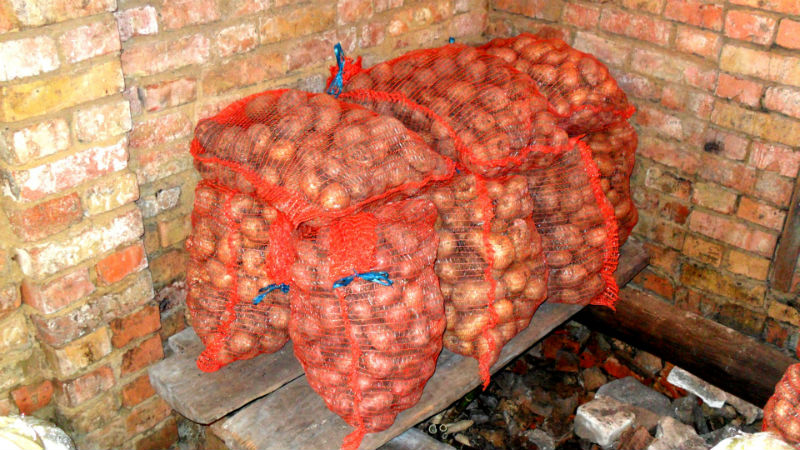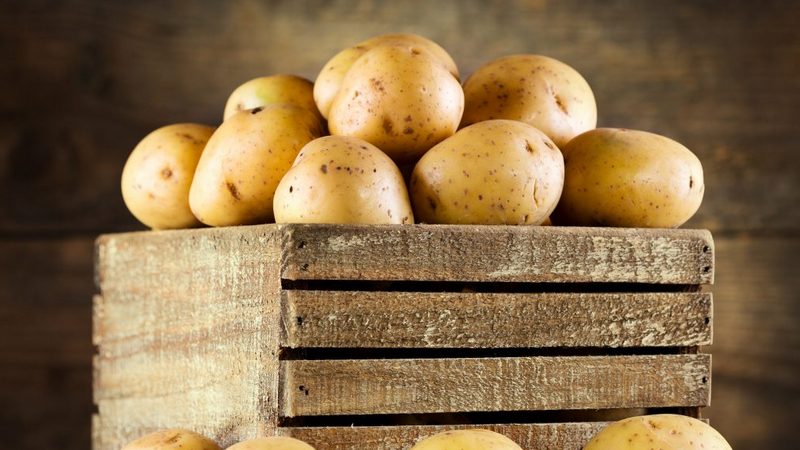What to do if potatoes rot in the cellar, why this happens and how to prevent the problem
Quite often, vegetable growers are faced with the problem of potato rotting after harvesting. This is due to the development of pathogenic microorganisms. If planting, harvesting and storing improperly, the crop will be lost. Therefore, it is important to know what to do if potatoes are rotting in the cellar. We will talk about this in our article.
The content of the article
Reasons why potatoes rot
Harvesting vegetables in rainy or damp weather, carelessness when examining the harvest, too early or late harvesting are the main reasons rotting potatoes.
Important! To prevent decay, the room is periodically ventilated.
In the cellar, vegetables quickly rot at high humidity, inappropriate temperatures, poor ventilation, storage in bags with low air permeability.

Diseases
Decay is caused by some dangerous diseases: late blight, bacterial rot, black scab.
Late blight
Fungal disease manifests itself as dark spots on the tubers. When cut, it can be seen that the black rot goes inside the potato.
Late blight occurs even during the growing season, and is activated already in the cellar if the temperature exceeds normal.
Basic control measures:
- the potatoes are sorted out, the infected tubers are removed;
- normalize the room temperature;
- healthy vegetables are processed with biological products (for example, "Gamair").
Dug up potatoes only in sunny dry weather, pour in boxes a layer of about 1 m.
Wet bacterial rot
With this disease, tubers become covered with patches of gray mucus with a terrible smell in a couple of days. Temperatures above + 20 ° C and humidity over 90% provoke the development of the disease.
To get rid of rot, do the following:
- the crop is sorted out and rotten tubers are thrown away;
- normalize humidity and temperature in cellar;
- sore areas on vegetables are cut off, the cut site is treated with alcohol;
- potatoes are periodically inspected.
Black scab
Fungal disease causes small black dots (sclerotia) on the tubers, cracks. Rhizoctonia disease does not affect the taste of vegetables, usually associated with late harvest.
Attention! The scab is passed on to the next generation of culture.
Disposal and prevention measures:
- the tubers are sorted out and the damaged ones are thrown away;
- the crop is treated with the "Ditan M-45" agent (200 g per 5 l of water, the solution is enough for 100 kg of potatoes);
- normalize storage conditions.
How to store potatoes in the basement

To the harvest was kept in the cellar for a long time, follow the basic rules:
- The room begins to be prepared about a month before the vegetables are laid: it is cleaned of debris, inspected for cracks and holes, washed with soapy water, treated with a 10% solution of copper sulfate, dried well, ventilated for several days. The cellar is additionally insulated from winter frosts, the floor is covered with lime to get rid of excess moisture.
- Potatoes are dried 5-15 days after clearing from the ground, sorted, infected, mechanically damaged and unsuitable for storage specimens are removed.
- Make sure that the temperature in the basement is within + 2 ... + 4 ° C, the humidity is about 90%.
The tubers are periodically inspected for suspicious spots and growths.
Important! Potatoes are sensitive to environmental changes, so they are kept in wooden boxes or bins with felt cloth at the bottom, sealed containers or bags. Plastic bags and tight, air-tight bags will not work.
How to process potatoes
Before placing vegetables peeled from the ground in the cellar, they are treated with chalk or wood ash. From chemicals used "Fitosporin", "Antignil", copper sulfate, Bordeaux liquid.
All containers for vegetables are pre-disinfected with a solution of potassium permanganate.
Why does potatoes rot immediately after harvesting
Immediately after harvest, the crop rots due to the influence of pathogenic fungi and bacteria. To prevent the problem, it is important not only to be attentive to the preparation of vegetables and storage rooms, but also to follow the agricultural techniques of growing crops:
- plants are planted at a temperature not higher than + 15 ° C;
- the soil must be fertile (it will be hard for potatoes in clay soil);
- seed tubers are cultivated in whole or in slices, which are dried in advance and rolled in ash;
- the site is regularly weeded from weeds;
- monitor the level of soil moisture.
If the potato is already sick, proceed as follows:
- The crop is sorted out, getting rid of rotten and damaged tubers.
- Healthy specimens are treated with contact fungicide "Ditan M-45".
- Vegetables and cellar dry well.
- If new fungal or bacterial formations appear on the potatoes, the procedures are repeated.

Why potatoes are covered with white mold
The appearance of mold is associated with improper storage conditions of vegetables.
Preventive measures:
- selection of varieties with strong immunity, high keeping quality;
- periodic ventilation of the cellar;
- humidity and temperature control;
- disinfection of tubers and premises;
- laying only ripe vegetables;
- basement isolation from groundwater;
- regular inspection of tubers for suspicious lesions.
If mold appears during storage, take the following measures:
- The crop is removed from the premises, kept under an ultraviolet lamp for 5-6 hours.
- Lime mortar is used to clean the walls, ceilings and the bottom of the cellar.
- Infected tubers are discarded.
- To reduce air humidity, place a container with slaked lime. The vegetables themselves are sprinkled with sawdust or wood ash.
Sometimes smoke bombs are used indoors.
Tips & Tricks

When planting a crop, a variety suitable for long-term storage is chosen: Picasso, Asterix and others.
Potatoes are not kept with other vegetables, except for beets: they are laid out in 1-2 layers on the tubers to remove excess moisture.
To reduce the temperature in the cellar during spring warming, place several pre-frozen water bottles.
Conclusion
When choosing a suitable variety, preparing tubers and a cellar, observing optimal temperature and humidity, the crop will not lose its qualities until spring.
If the vegetables have already begun to rot or become moldy, they are sorted out, disinfected along with the room, everything is dried well. Do not neglect the basic rules of growing and storing crops, and then the risk of problems will be minimal.